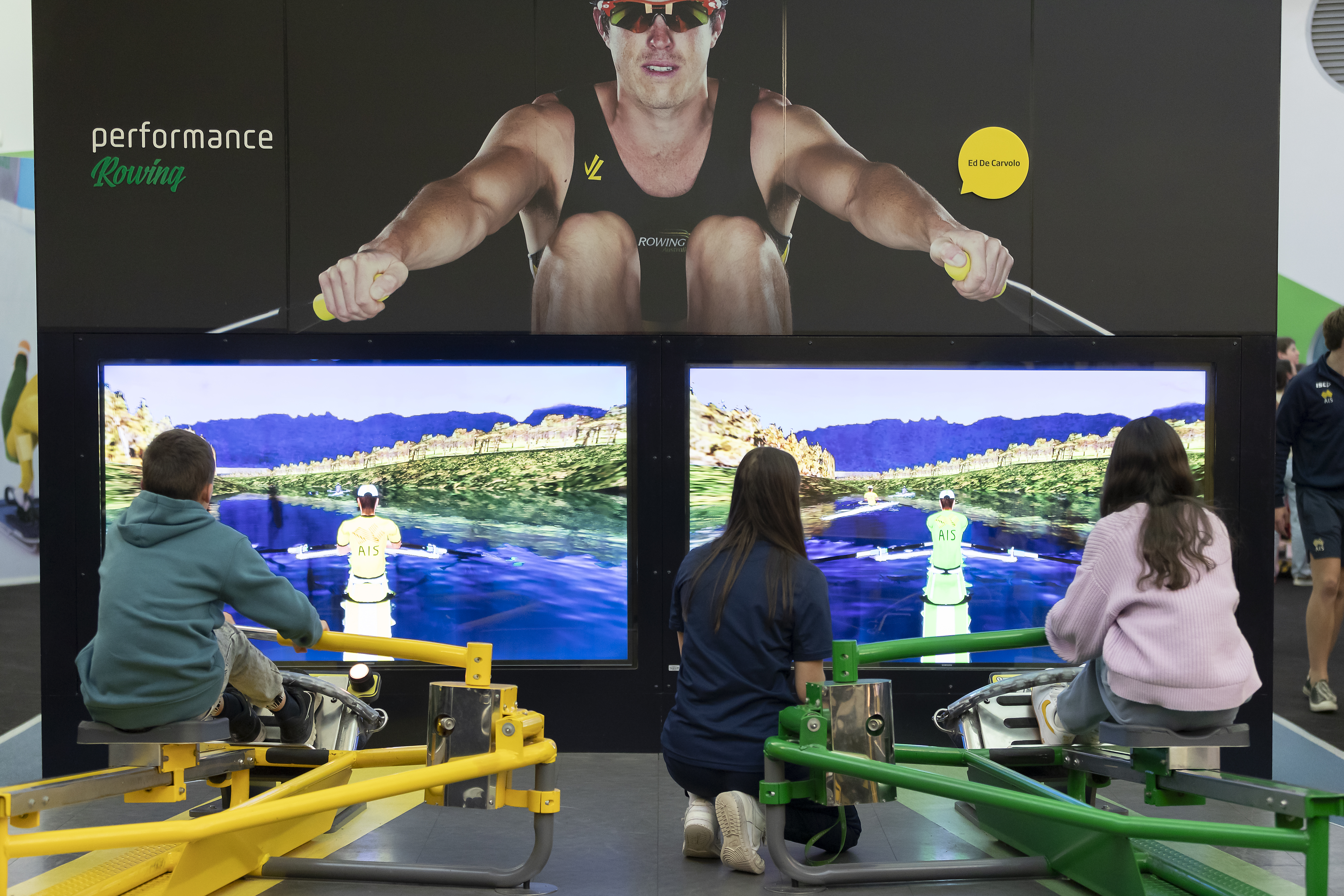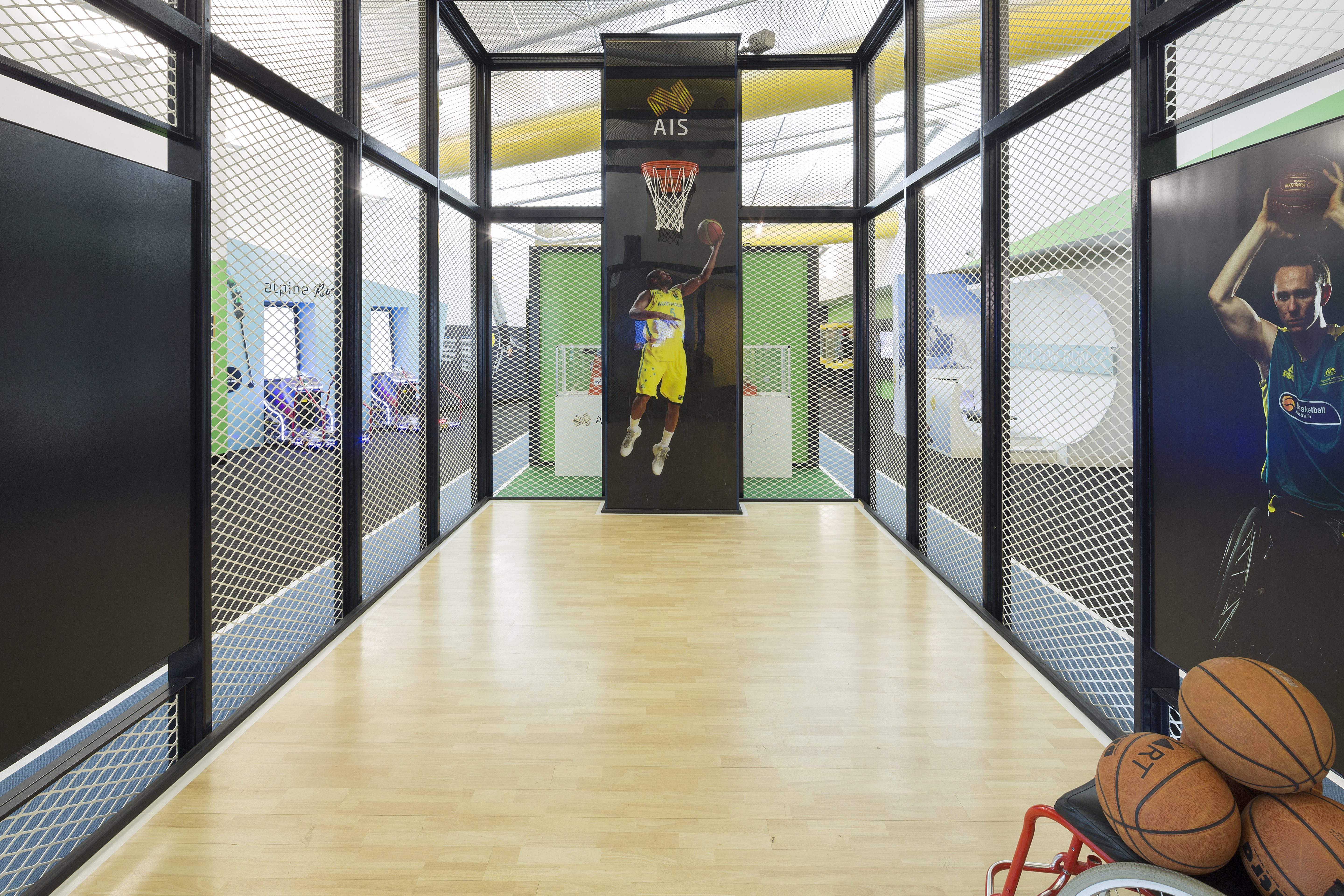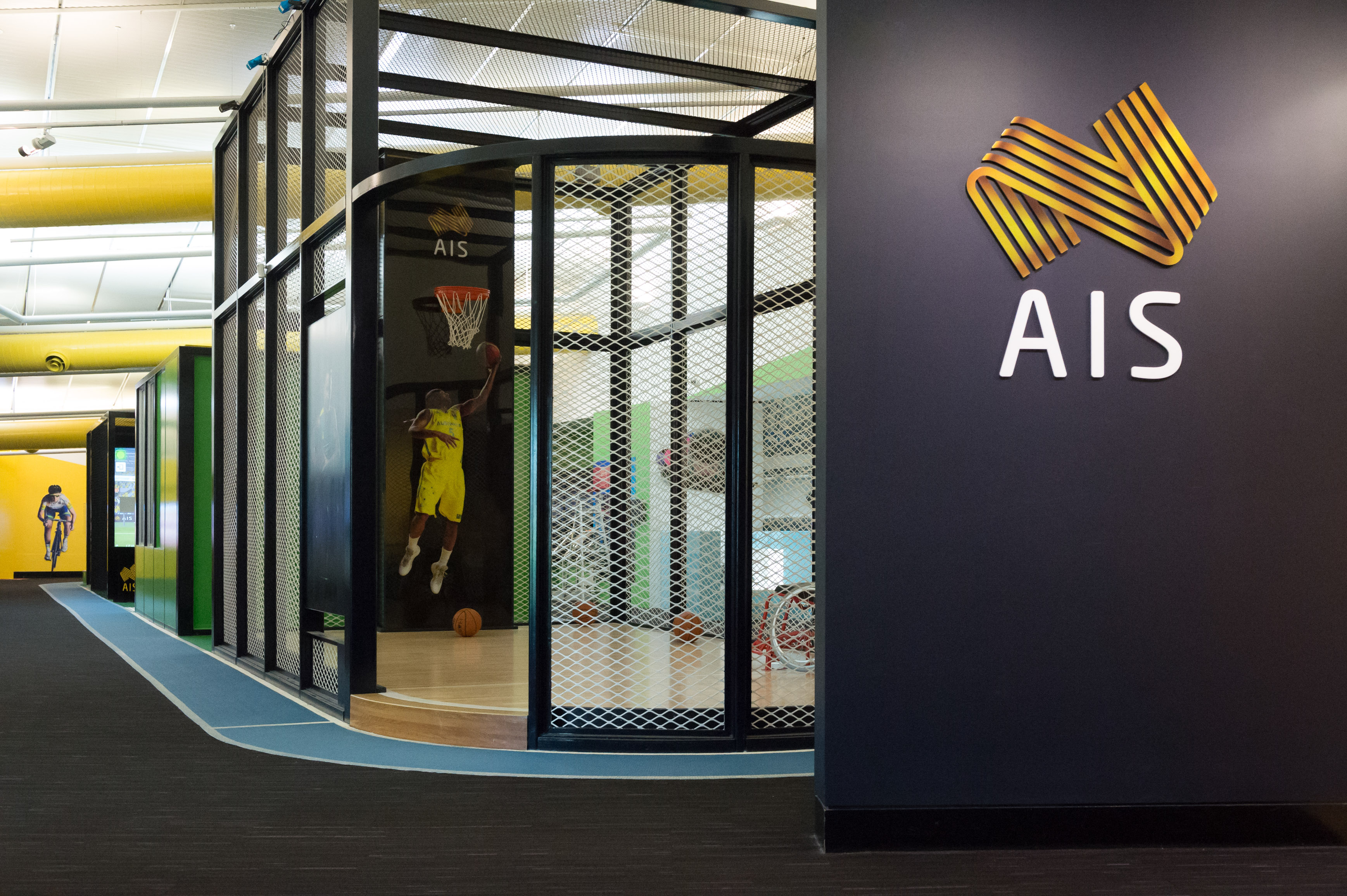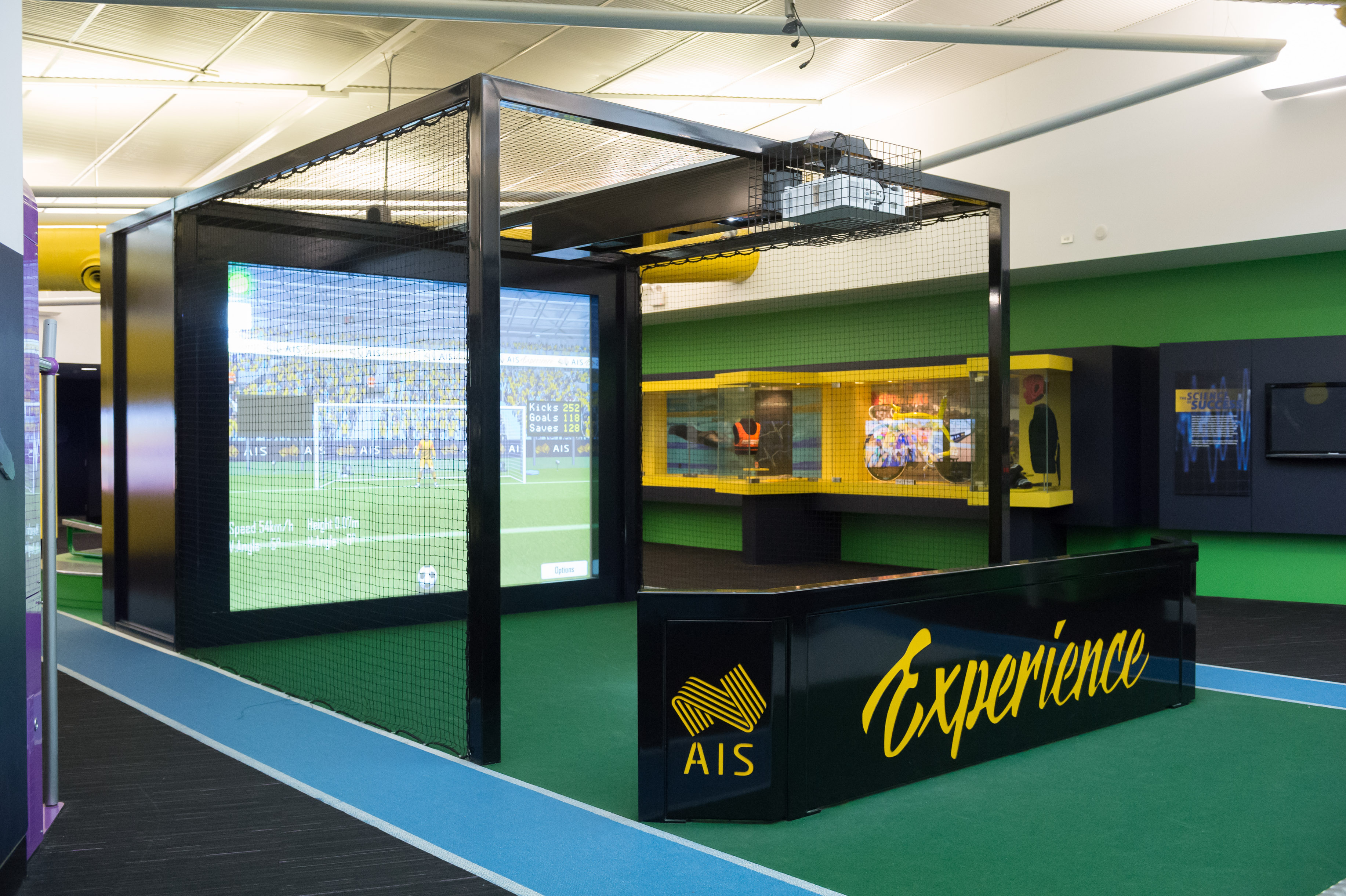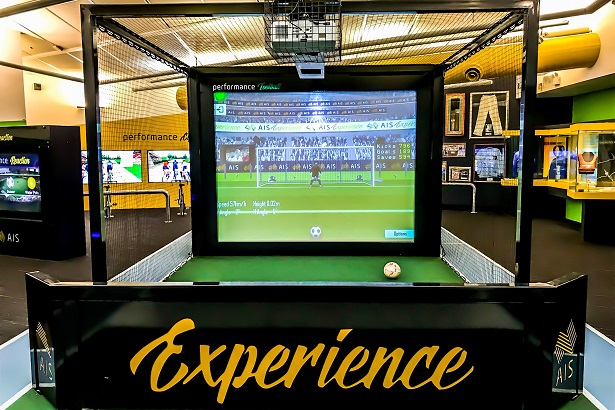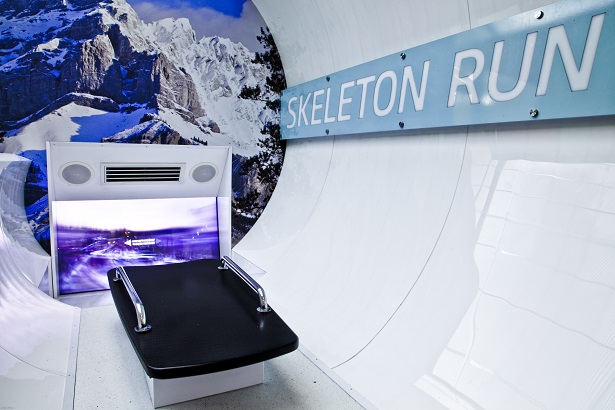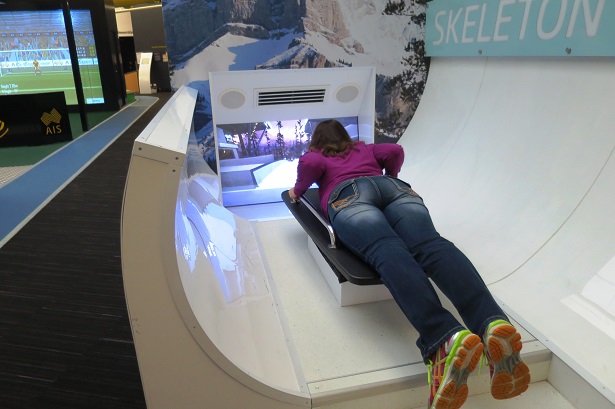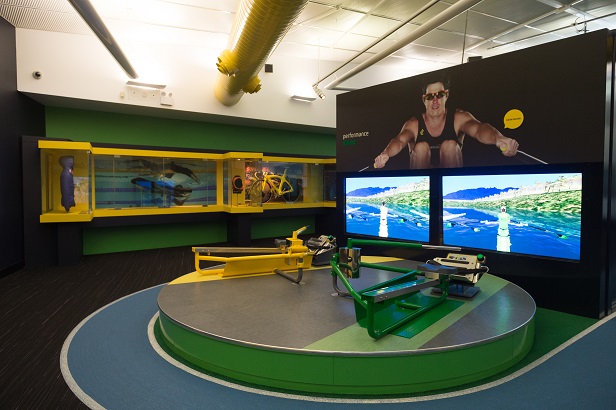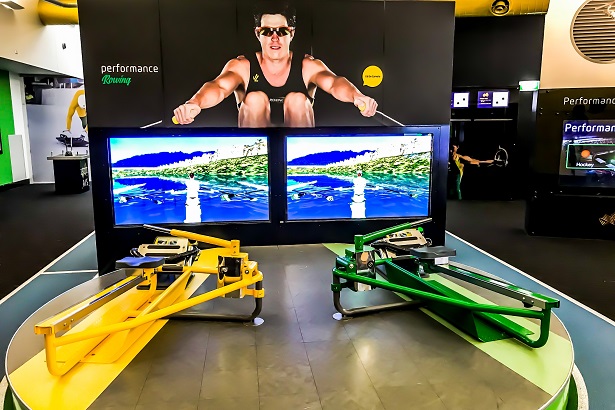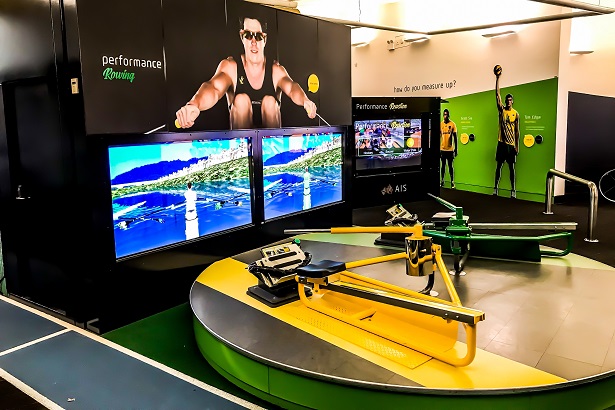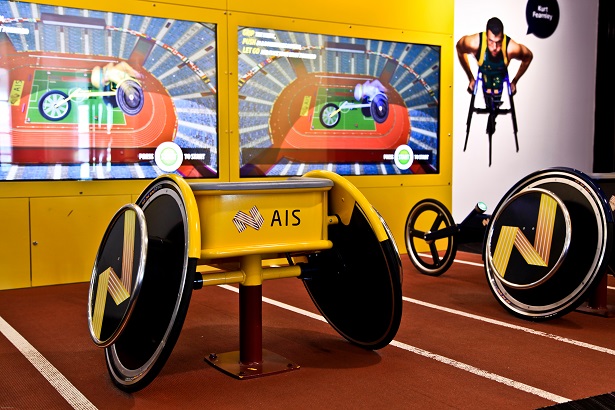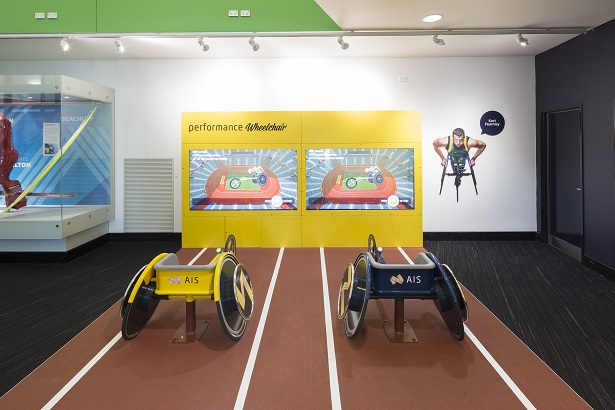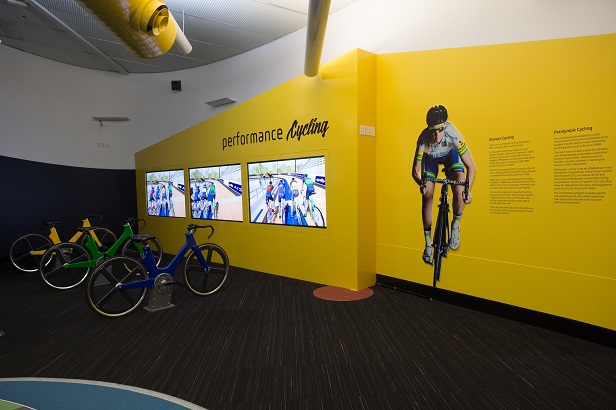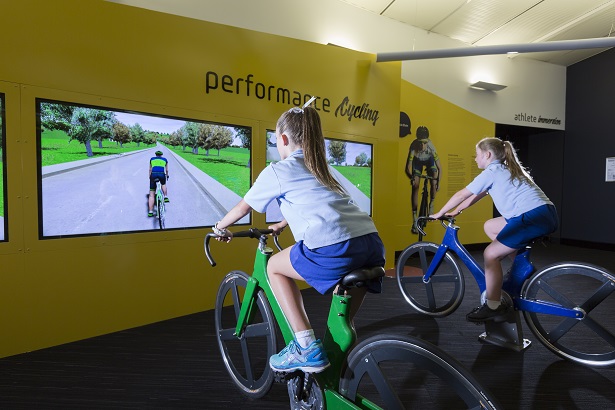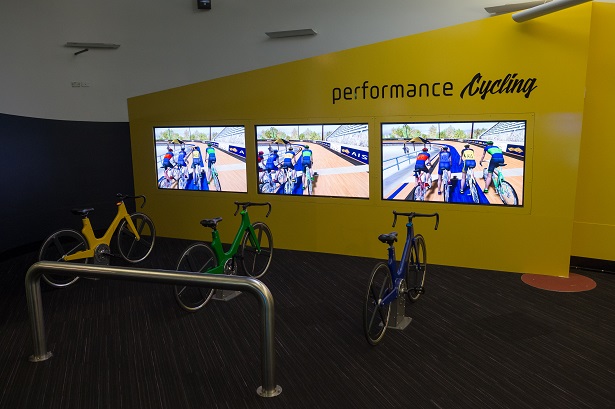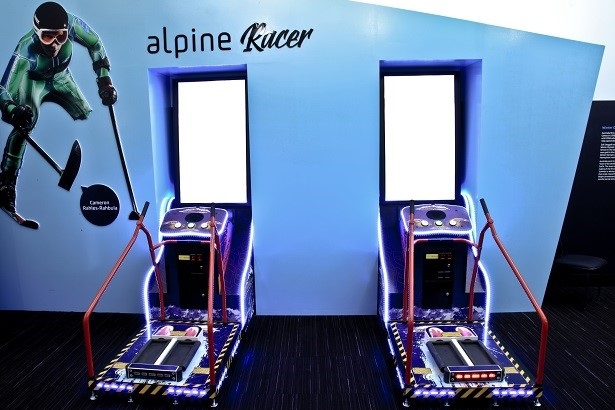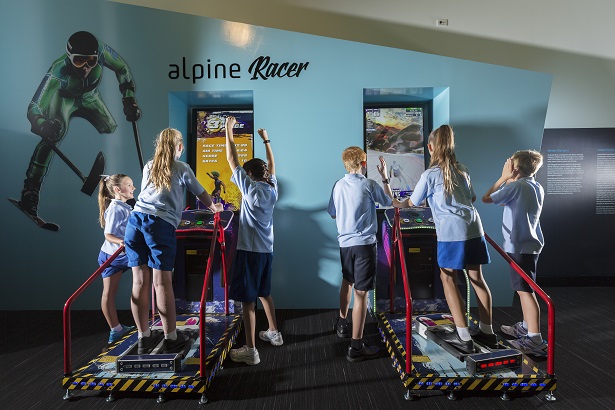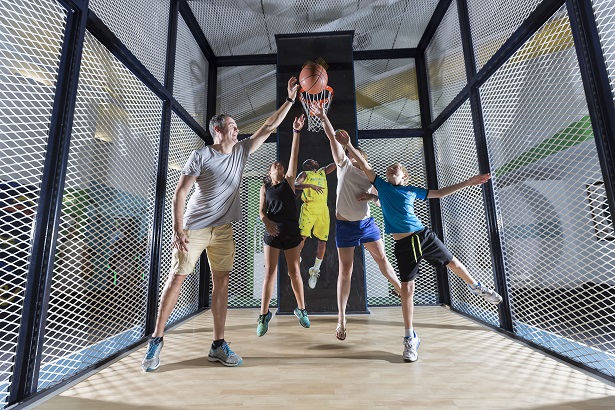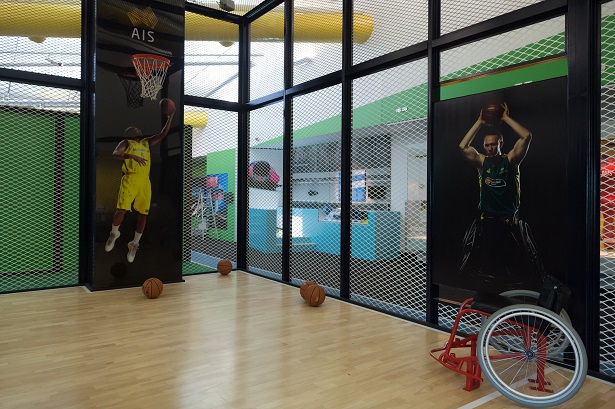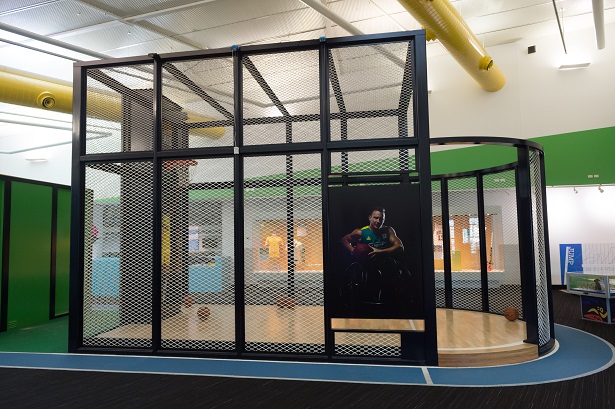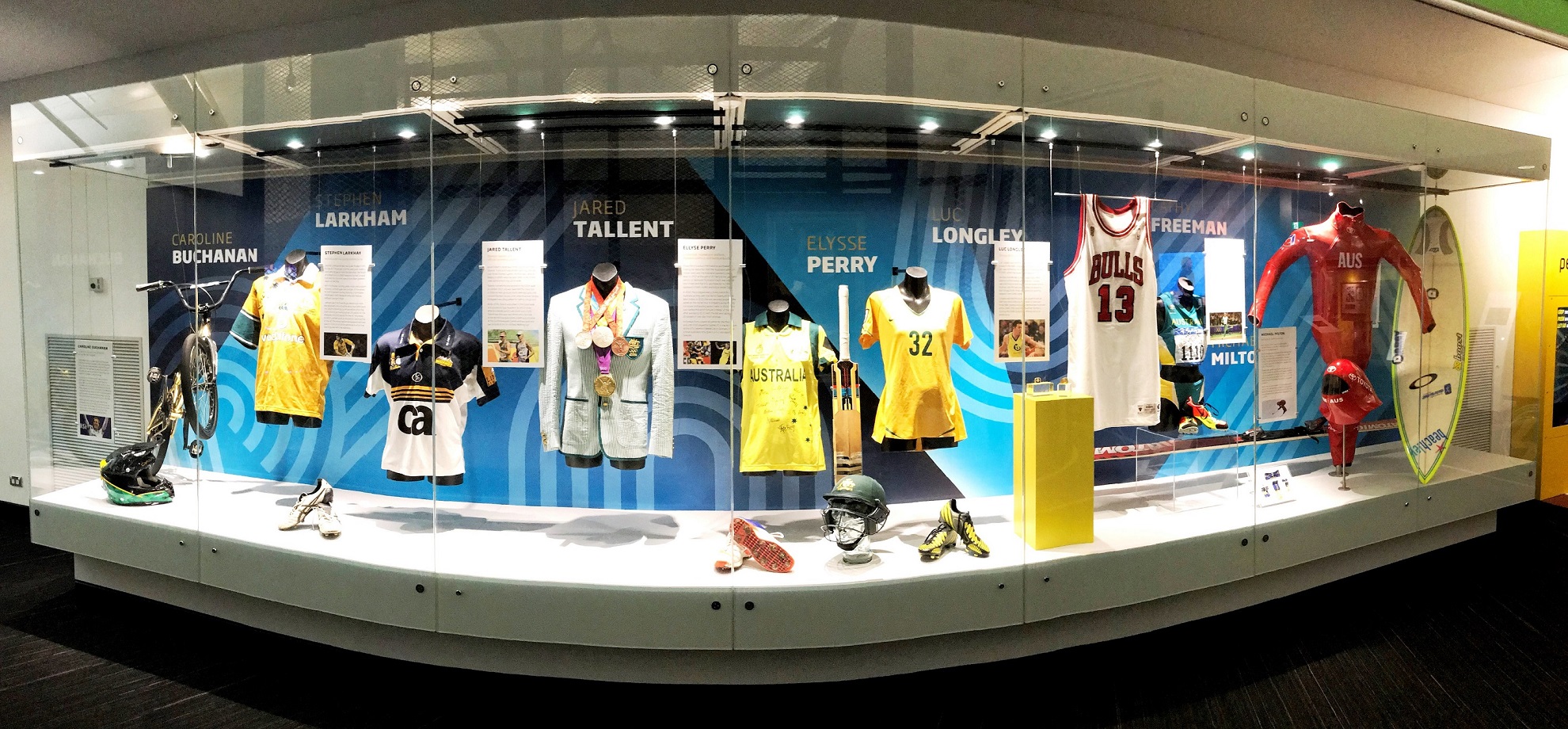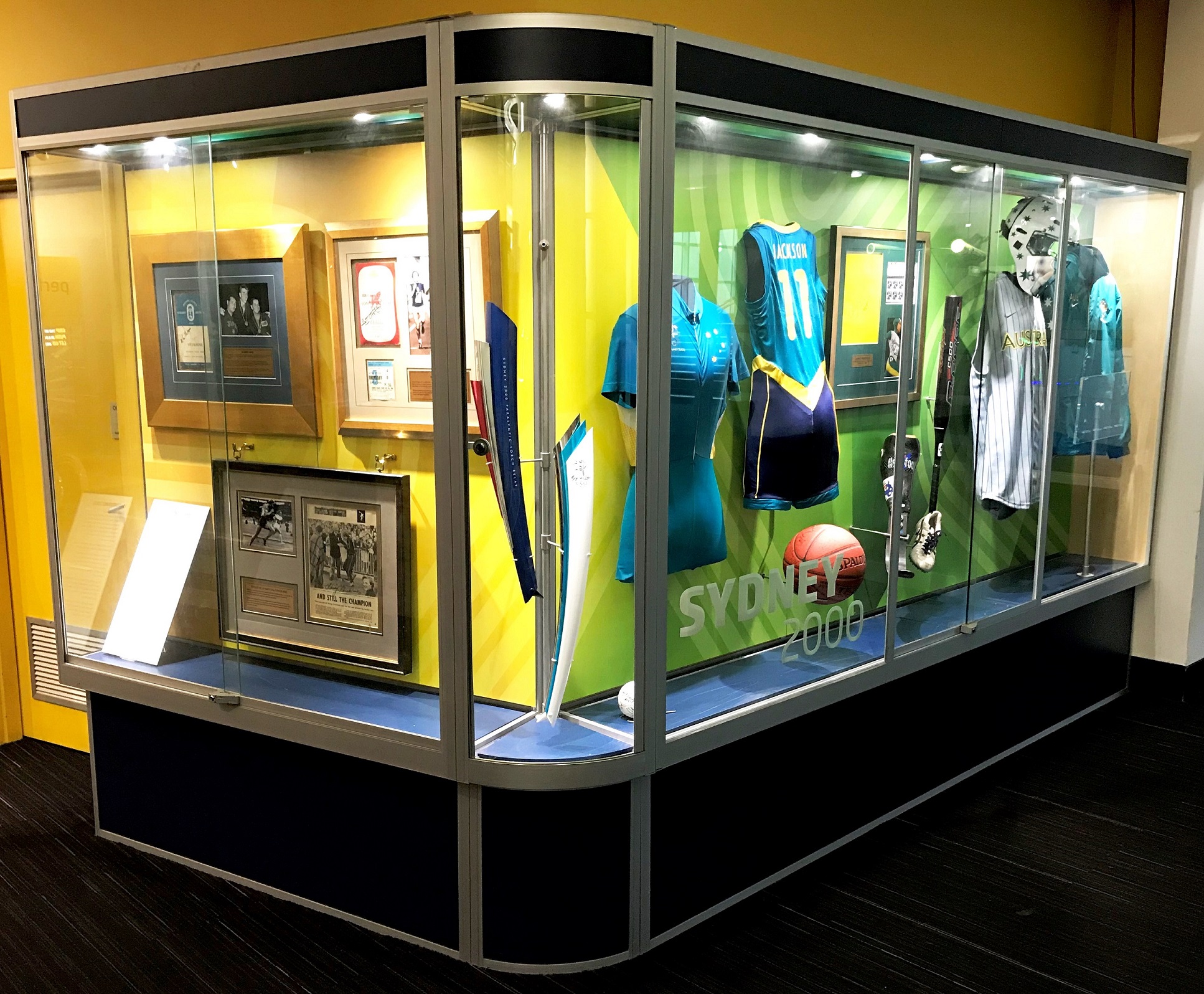For more information visit AIS News
Challenge yourself in Sportex, a leading interactive sports exhibit set among a unique collection of Australian sporting memorabilia.
Visitors can enjoy fun and safe interactive displays, learn about the history of Australian sport and be inspired to be active and play sport.
Sportex is included as part of every AIS Tour, but please note Sportex can not be undertaken on its own.
Sportex is also ideal for cocktails or other events for up to 120 guests.
Athlete Immersion
Have you ever imagined what it would be like to be a High Performance Athlete during a training session or National competition?
Whether it is Caroline Buchanan during the National BMX Championships, Lewis Cressy on a downhill mountain biking run, boxer Shelley Watts during a sparring session, going head first down the official Pyeongchang Winter Olympic Skeleton Run or carving through the waves with Australian Surfer Eddie Kelly.
Here within Sportex we offer visitors an intimate first person perspective of what it would be like to be one of Australia’s High Performance Athletes. Have you ever wondered what it is athletes are seeing? Well here is your opportunity.
Performance Football
We have developed a state of the art Football environment where players can compete in a number of disciplines. During gameplay, attempt to create goal-scoring opportunities through individual control of the ball, such as passing to a teammate, mastering the corner shot, hitting targets, and taking shots at the goal guarded by the opposing goalkeeper. Do you have what it takes to beat the keeper? Then let’s see what you’ve got.
Football is a team sport played by over 250 million people in over 200 countries, making it the world’s most popular sport.
Australia entered a men’s football team at Melbourne 1956 but did not compete again until Seoul 1988. The side's best result was a superb fourth at the Barcelona Games in 1992. Australia began competing in Women’s football at Sydney 2000. At the Rio 2016 games, the side went down in a heartbreaking penalty shootout in the quarter finals against Brazil.
Skeleton Run
We have developed a digital environment and game play that provides a virtual HD gaming experience for the skeleton interactive. This interactive provides visitors the ability to control the sled and associated speed through turns to optimise their run to the finish line. Want to go head first down the Chute? Then lay down, hold and on feel the wind through your hair.
Skeleton is held on a 1200m long track that is also used by Luge and Bobsleigh. Runs are timed electronically to 0.01 seconds with competitors travelling as fast as 130km/hr. Only the head first position is allowed. To gain momentum, the athlete pushes the sled at the start before diving into position. Athletes use spiked shoes to help them grip the ice while exploding at the start.
The high performance skeleton program from the AIS has targeted beach sprinters and track athletes producing a number of strong Australian competitors. Michelle Steele and Shaun Boyle became Australia's first Olympic skeleton representatives when they competed at the Torino Games in 2006.
Performance Rowing
We offer visitors the opportunity to race along the Sydney International Regatta Centre in Penrith, the same course used during the Sydney 2000 games. Do you have the performance endurance it takes to beat your mate, your family of even yourself in this Regatta style event?
Rowing is one of the oldest Olympic sports. In Olympic rowing 14 different boat classes are raced: eight sculling events in which two oars are used, one in each hand and six sweep-oared events in which the rower uses one oar with both hands.
Australia has forged a very proud history in Olympic rowing, particular in the sculling events, since sending its first rowers to the Stockholm Games in 1912. The legendary Henry ‘Bobby’ Pearce won the single sculls at Amsterdam 1928 and Los Angeles 1932. More recently, Kim Brennan won gold at the Rio 2016 Games in the women’s single sculls.
Wheelchair Racer
We have engaged the services of one of Australia’s leading exhibition planning, design and interactive specialists, to build one of the only competitive, two player Wheelchair racing simulations in Australia. You can challenge your mates or yourself in this realistic Paralympic experience and see if you can beat the current World Record as you go.
Wheelchair racing is the racing of wheelchairs in track and road races. Wheelchair racing is open to athletes with any qualifying type of disability, amputees, spinal cord injuries and cerebral palsy. The specialised wheelchairs allow the athletes to reach speeds of 30 km/h or more. It is one of the most prominent forms of Paralympic competitions.
Louise Sauvage is an Australian legend of wheelchair racing. She was just 16 when she participated at her first IPC Athletics World Championships, where she won gold in the 100m in world record time. She went on to change the sport of wheelchair racing by becoming one of its first truly professional athletes and, in the process, dominated it for a decade raising the profile and perception of Paralympic sport and Paralympic athletes in Australia and around the world. Highlights of Louise’s sporting performances include nine gold, and four silver medals from four Paralympic Games, from Barcelona (1992) to Athens (2004), including four gold medals and two world records in Atlanta in 1996. She won Paralympic gold medals in every distance from 100m to 5000m.
Performance Cycling
We offer visitors the opportunity to test their skills and mettle at either the Road Race or Velodrome, on custom built bikes that are designed to give you the most realistic experience possible. Winner takes all as you challenge your mates to see who the true performance cyclist is.
Cycling events have been a part of every modern Olympic Games since Athens in 1896. Women’s cycling was introduced at the Los Angeles 1984 games.
The road cycling race is a mass start event and the first cyclist to cross the finish line at the end of the total distance is declared the winner. The men’s race is approximately 230km and the women’s, approximately 120km.
In terms of medals won per events contested, cycling is easily one of the most successful Olympic sports for Australia. Edgar Gray became Australia’s first cycling medallist in 1928, finishing third in the 1000 metres time trial in Amsterdam. In Barcelona 1992, Kathy Watt was the first Australian to win an Olympic gold medal on the road.
Alpine Racer
This remake of the arcade classic comes with brand new characters and completely redesigned courses. The Alpine Racer has a vertically mounted 55″ HD monitor. The multi-pivot platform simulates the movements of a downhill skier. Feel the wind through your hair from the built-in air blowers and shoot through the gates to gain an additional boost to speed past your opponents while performing insane tricks in the air. Want to be just like Greta Small ? Well here is your chance.
Alpine skiing involves all skiing events which occur on a downhill course and do not involve ramps or awkward bumps. Alpine racing is a beat the clock format in which a skier goes down the mountain from Point A to Point B and the fastest time wins.
Zali Steggall remains Australia’s only Games medallist in the sport having won bronze in the Slalom event at Nagano in 1998. The medal was also Australia’s first individual Winter Olympic medal.
Wheelchair Basketball
Integrating a wheelchair into the basketball half court allows visitors the opportunity to test not only their jump shots and free throw skills but also let them see how much harder when you are sitting in a real wheelchair basketball chair. Do you think you can make the transition and still get nothin’ but net?
Wheelchair basketball was one of the foundation sports on the Paralympic program in Rome in 1960. Today, it continues to be one of the most popular sports at the Paralympic Games. To be eligible to play wheelchair basketball, a person must in their lower limbs have an objective and measurable permanent physical disability, which prevents them from running, jumping and pivoting as an able-bodied player.
The Australian men’s team (the Rollers) has competed at every tournament at the Paralympic Games except 1964 and won the Gold medal at the 1996 Atlanta Games and 2008 Beijing Games. The Women’s team (the Gliders) started competing at the 1992 Barcelona Games and then went on to win either the silver or bronze medal from the 2000 Sydney Games through to the 2012 London Games.
Heroes and Legends Display
The Heroes and Legends Display is an opportunity to recognise and celebrate athletes who have achieved something unique or extraordinary and who have become role models and inspirations in their respective sports and to all Australian. The display currently showcases:
- Caroline Buchanan’s Rio 2016 BMX racing bike and helmet;
- Stephen Larkham's Wallabies Jersey and Brumbies Jersey and Boots;
- Elysse Perry's Cricket bat, helmet and uniform, Matilda’s uniform and football boots;
- Jared Tallent's Olympic medals and official ceremony jacket;
- Luc Longley's 1996 Chicago Bulls jersey, 1996 and 1998 NBA Championship winning rings;
- Michael Milton's Racing suit, helmet and skis; Layne Beachley's surfboard; and
- Cathy Freeman's running suit and shoes.
Australian Olympics Display
The display showcases Olympic and Paralympic Games held in Australia.
The Melbourne Olympics in 1956 were the first Olympic Games held outside Europe or the United States, the first that featured live television broadcasts and the first where the athletes walked together as one in the closing ceremony. Australia achieved third place on the medal tally – still the nation’s best performance ever. Notable performances came from Shirley Strickland (gold medal in the 80m hurdles), Betty Cuthbert (first Australian to win three gold medals at a single Games) and Murray Rose (also winning three gold medals in Swimming).
The Sydney 2000 Olympic Games, in the words of IOC President Juan Antonio Samaranch, were the “best games ever.” They brought 199 nations, 10,651 athletes competing in 28 sports. Performances at the opening and closing ceremonies celebrated Australia’s history and culture, with sporting icon Cathy Freeman lighting the flame. Australia had their best Olympic standing ever finishing fifth overall with 16 Gold, 25 Silver and 17 Bronze Medals.
